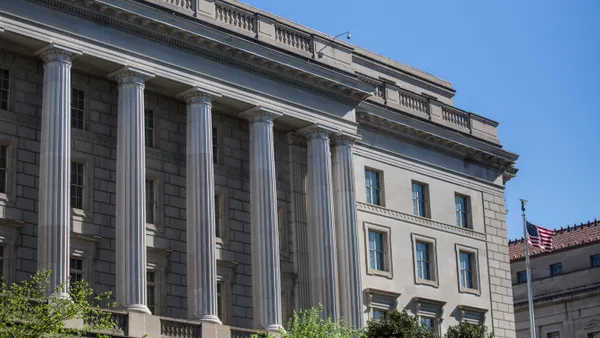Dive Brief:
- Risks persist in the transition away from the London Interbank Offered Rate (LIBOR) even though Congress has passed legislation aimed at ensuring a smooth switch to a new reference rate for financial contracts lacking clear fallback language, Fitch said.
- “There remains a risk that parties may delay or have difficulty making the conforming changes” under regulations that the Federal Reserve will create in coming weeks clarifying how so-called legacy LIBOR contracts will adopt a new benchmark rate, according to Fitch. “Operational challenges could arise in implementation.”
- “For consumer loan contracts, only conforming changes approved by the Fed are allowed and would be covered under the act," Fitch said. “Regulations should clarify how this will be implemented.”
Dive Insight:
The Senate on Thursday approved 68-31 a $1.5 trillion package of spending that included aid for Ukraine and provisions related to the LIBOR transition. The Senate acted a day after the U.S. House approval of the bill, which now awaits President Biden’s signature.
The legislation creates a safe harbor for contracts lacking a replacement rate for LIBOR and directs the Fed, when necessary, to determine a new benchmark rate. The Fed and its Alternative Reference Rates Committee (ARRC), a panel of financial institutions, favor the use of the Secured Overnight Financing Rate (SOFR).
The central bank has 180 days to draw up corresponding regulations.
Some $16 trillion in financial contracts lack fallback language and, without congressional action, would be “subject to thousands of lawsuits,” according to Rep. Brad Sherman, D-Calif., who introduced the bill in the House in July.
Fed Chair Jerome Powell and “Treasury Secretary Janet Yellen have testified before our [financial services] committee that this $16 trillion problem poses a ‘systemic risk’ to our economy, and that legislation was necessary,” Sherman said. “This legislation provides a structural bridge, removing uncertainty and reducing systematic disruption in the markets.”
Fitch agreed the law will reduce the odds of market turmoil. The legislation “provides strong protection for legacy contracts without workable fallback provisions, significantly reducing transition and disruption risks upon eventual [U.S. dollar] LIBOR phase-out.”
U.S. regulators have pressed companies for years to sunset LIBOR, the reference rate for mortgages, derivatives, business loans and other financial contracts worldwide and the subject of a manipulation scandal in 2012. They have barred U.S. financial institutions from writing new contracts using LIBOR since the end of last year.
LIBOR is derived from London banks' estimates of what they would be charged when borrowing from other banks, whereas SOFR is based on overnight repurchase agreements secured by U.S. Treasurys.
The final fixings for most LIBOR rates — including one-week and two-month U.S. dollar LIBOR — were made on Dec. 31, but other U.S. dollar tenors may continue until June 30, 2023.
The recently passed “legislation is important to prevent any disruptions to business financing, particularly in these uncertain times,” according to Tom Quaadman, executive vice president at the U.S. Chamber of Commerce’s Center for Capital Markets Competitiveness.
SOFR will probably not be the only LIBOR substitute businesses will adopt, Fitch said. “U.S. banks may use any reference rate other than LIBOR for loans, provided that management determines it is appropriate based on its funding model and customer needs.”
“We expect some banks, particularly community and regional banks, to opt to use credit-sensitive benchmarks such as the American Financial Exchange’s Ameribor or Bloomberg’s Short-Term Bank Yield Index in lieu of SOFR, which may result in a multi-rate environment in the U.S.,” Fitch said. “However, as the SOFR debt pipeline builds, so does the depth and liquidity of SOFR swap trading, which may mean the market coalesces around SOFR over time.”















